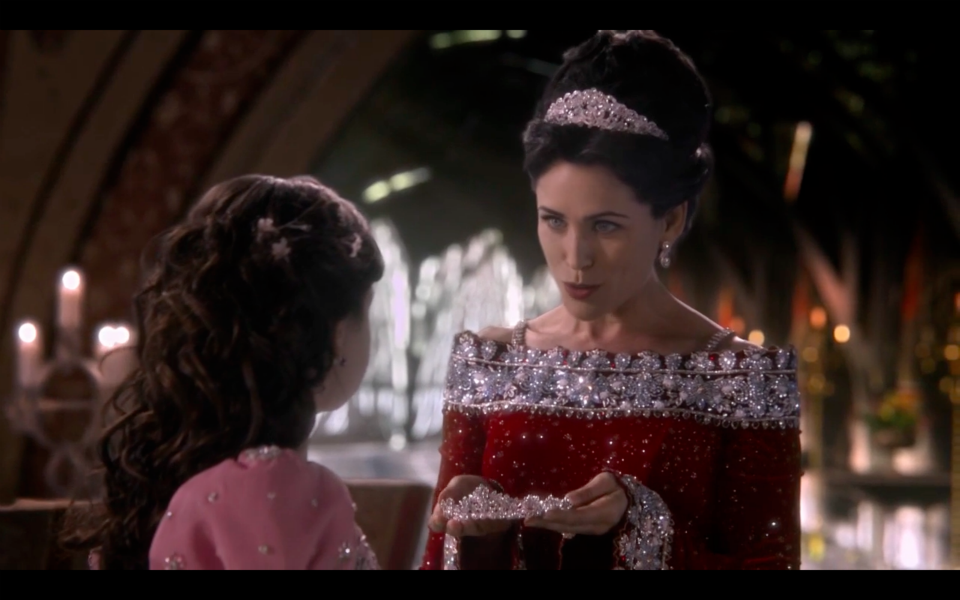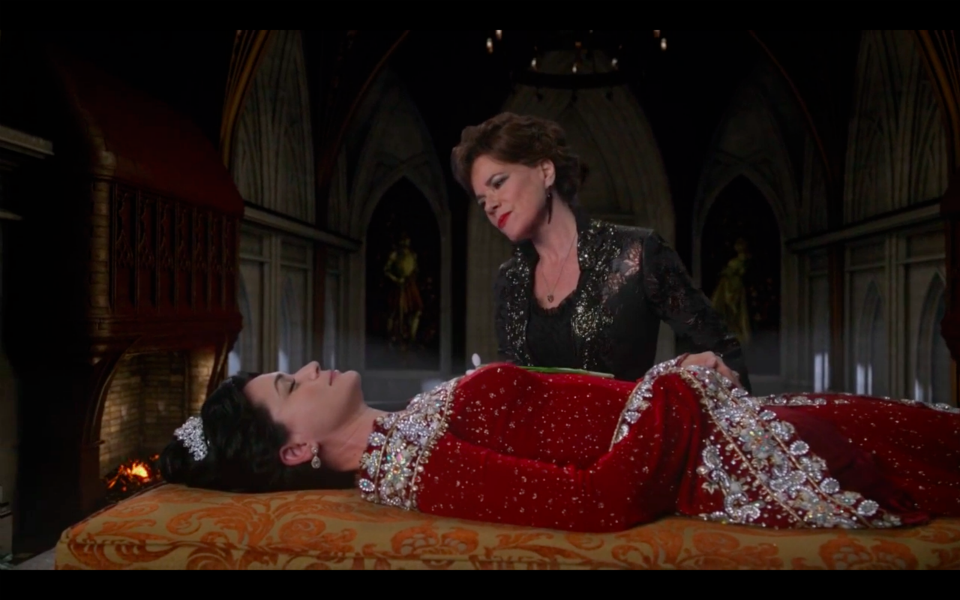|
The Three Queens Eva, Snow, and Emma’s parallels with Traditional Christian Narrative by Teresa Martin--@Teresa__Martin Fans were thrilled when it was announced that an episode of Once Upon A Time would feature Snow’s mother. This opened up an entirely new character to explore. Of one thing I was certain, since Snow White’s mother had been established as dead it was likely that she would not be represented with the apple as her symbol. That is usually the provenance of the evil step-mother. I felt that I could put away my notes on the apple for a while. There is nothing I have against that rich symbol but I’ve already explored this theme so often that I was concerned my “Apple and Eve” symbolism was getting a little redundant. I’m surprised I have not gained the nickname “Crazy Apple Lady,” or even “Defendrix Mali.” Many possible scenarios went through my mind about how I may approach this new character and her famous daughter. I was determined that the only reason I would use the famous Garden of Eden story in this essay is if the writers went ahead and plain named the character “Eve.” A few weeks later a press release hit the web for “The Queen is Dead.” Oh. So how about those apples? Back to the Garden of Eden we go! This myth describes the great fall of humanity and locks into Snow’s mother from her name to the color of her dress. The apple is the Forbidden Fruit, a symbol of knowledge and original innocence that Adam and Eve rejected when they chose to listen to the devil, symbolized by a serpent, and ate the fruit which represents the choosing of good over evil. Eating the apple, one could say, is analogous with “crossing the line,” the act from which no person may return, so prevalent in fairy tales. However, watching the episode “The Queen is Dead” it quickly became clear that this Eva is far from the stereotypical Eve, seductress and tempter of man. Rather from her words, to their tone, and the gentle musical score, Eva is an ethereal character, almost too good to be true, giving sage advice to her daughter and accepting painful death with an astonishing peace. A week later, in “The Miller’s Daughter,” the audience learned that Eva was not kind or empathetic in her younger years. Rather she was a woman of pride who was so petty and cruel that she went out of her way to humiliate Cora, a peasant, purely for amusement. Yet this superior attitude did not last long. Young Eva is disgraced when this same peasant wins the favor of the king for spinning gold and then endures the shame of having her intended propose to another woman in front of her. Not shown onscreen, but likely to have occurred, was Eva being packed off and sent home to her kingdom as a princess who was jilted over a peasant, an object of ridicule even. Likely, given her later persona, instead of turning to bitterness and revenge, Eva chose the better path, transforming her ways such that the woman we see in “The Queen Is Dead” is the New Eva, redeemed.
0 Comments
Mix and Match by Teresa Martin--@Teresa__Martin One of the most exciting aspects of Once Upon a Time is the way that the show takes the fairy tale characters that we are familiar with and puts a modern twist on them. Hence it was rather shocking to discover the ultimate twist while researching the Grimm Brothers: the Evil Queen is actually Snow White’s mother! The original story, based on the oral version that had been passed on over the years, had the Queen who so famously wished for a daughter, actually growing jealous of her. So even though Once has the claim-to-fame of twisting fairy tales for a modern age, it was the Grimms themselves who are responsible for the ultimate switch-a-roo. When they published their work in 1812, many were reading the tales for the first time, and, finding that the stories were popular with children, they chose to tone it down in the second edition to change the evil birth- mother to the stepmother. That is how the evil stepmother was created. So why not add another twist as was presented in “The Queen is Dead” and have a Snow White who finally has decided “Enough is Enough! I have had it with these mother-censored good decisions on these mother-censored Lands,” and go Medieval on Cora? Why not indeed? The Grimms originally recorded the tale “Sneewittchen” from oral interviews given with those of lower to middle classes who recited in the Low German dialect what they recalled from childhood, or from the hours spinning and telling the tales to each other to pass the time. The narrative generally went as the brothers recorded it: Once upon a time in the middle of winter, when snowflakes the size of feathers were falling from the sky, a queen was sitting and sewing by a window with an ebony frame. While she was sewing, she looked out at the snow and pricked her dinger with a needle. Three drops of blood fell onto the snow. The red looked so beautiful against the white snow that she thought: “If only I had a child as white as snow, as red, as blood, and as black as the wood of the window frame?" (Tatar) Fairy Tale scholars Sandra Gilbert and Susan Gubar have analyzed that the queen is a woman “confined” (Tatar, 249). A person thus trapped usually seeks an escape, often in a superficial solution. In this case it was in a beautiful baby with desired features. Also notable is the tri-fold formula of the blood drops: divine, supernatural, perfect. There is something mystical and pure therefore in the wish upon which Snow’s conception occurs. The Queen’s later jealousy gives a new meaning to be careful what you wish for. “All ‘magic’ comes with a price” and the price was granting her wish. For her child became all that she wished for and hence her rival. |
OriginsExplore the Arthurian legend surrounding Lancelot, take a trip into the woods to discover the mythology behind Red Riding Hood or learn more about a modern day hero called Snow White. Origins provides unique insights and perspectives from talented writers into the characters we know and love, going far beyond the boundaries of Storybrooke. Archives
August 2016
Categories
All
|



